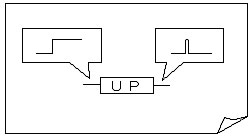Question
What is the difference between the CONDITION ON instruction (UP) for the CS/CJ-series Programmable Controllers, and DIFU instruction?
Answer
Both the CONDITION ON (UP) and CONDITION OFF (DOWN) instructions were added with the introduction of the CS/CJ-Series, but here we will explain only the CONDITION ON (UP) Instruction.
CONDITION ON Instruction (UP) Operation Specifications
When the execution condition to UP turns ON, the execution condition output from UP will turn ON for 1 cycle.

Figure 1
Note:What is PF?
PF is an abbreviation for power flow. The power flow is flow of the execution condition in a ladder program. It runs from left to right, expressing the result of the logical operators (instructions) such as AND, OR, and NOT as a binary signal (ON/OFF).
With the CONDITION ON instruction (UP), you do not have to use a work bit to process the differentiated status, which is necessary with the DIFU instruction. This operation of the CONDITION OFF instruction is shown in Figure1.
Differences between CONDITION ON Instruction (UP) and Other Differentiated Instructions
The differences between --|↑|--, the DIFU instruction, and the CONDITION ON instruction (UP) are given in Table 1.
| Instruction | Application and characteristics |
| --|↑|-- | Can be used only with LD/AND input instructions. |
| DIFU | A work bit is required to process the differentiated status. |
| UP | A work bit is not required to process the differentiated status. UP can also be used to process the results of LD, AND, and OR data comparison instructions. |
Table 1
Application Example

Figure 2
Program Operation
1.When the Device A Run Time (D201) reaches the Device A Time for Lubrication (CIO 1), the CONDITION ON instruction (UP) causes the execution condition to turn ON for one scan, which will turn ON the Device A Reached Time for Lubrication Bit (CIO 2.00) will turn ON. The self-holding bit (CIO 2.00) will cause the warning bit to remain ON.
2.When the Alarm Stop Pushbutton Bit (CIO. 0.01) turns ON, the self-holding bit will be reset, and the alarm output bit (CIO 2.00) will turn OFF.
Reference:
We have explained the CONDITION ON instruction (UP) here. The CONDITION OFF instruction (DOWN) is different only in that, when the input signal turns OFF, the execution condition will turn ON for one cycle. The other characteristics of the CONDITION OFF instruction (DOWN) are the same as those of the CONDITION ON instruction (UP).
Recommended Products
Other Programmable Controllers FAQ
-
 What products are recommended as substitutes for the C200H-CPU01 Programmable Controller?
What products are recommended as substitutes for the C200H-CPU01 Programmable Controller?
-
 How can I connect a C200H Programmable Controller's CPU Unit with an IBM PC/AT or compatible computer?
How can I connect a C200H Programmable Controller's CPU Unit with an IBM PC/AT or compatible computer?
-
 Why communication error occurs during CX-Programmer FA Integrated Tool Package get online with Programmable Controller?
Why communication error occurs during CX-Programmer FA Integrated Tool Package get online with Programmable Controller?





